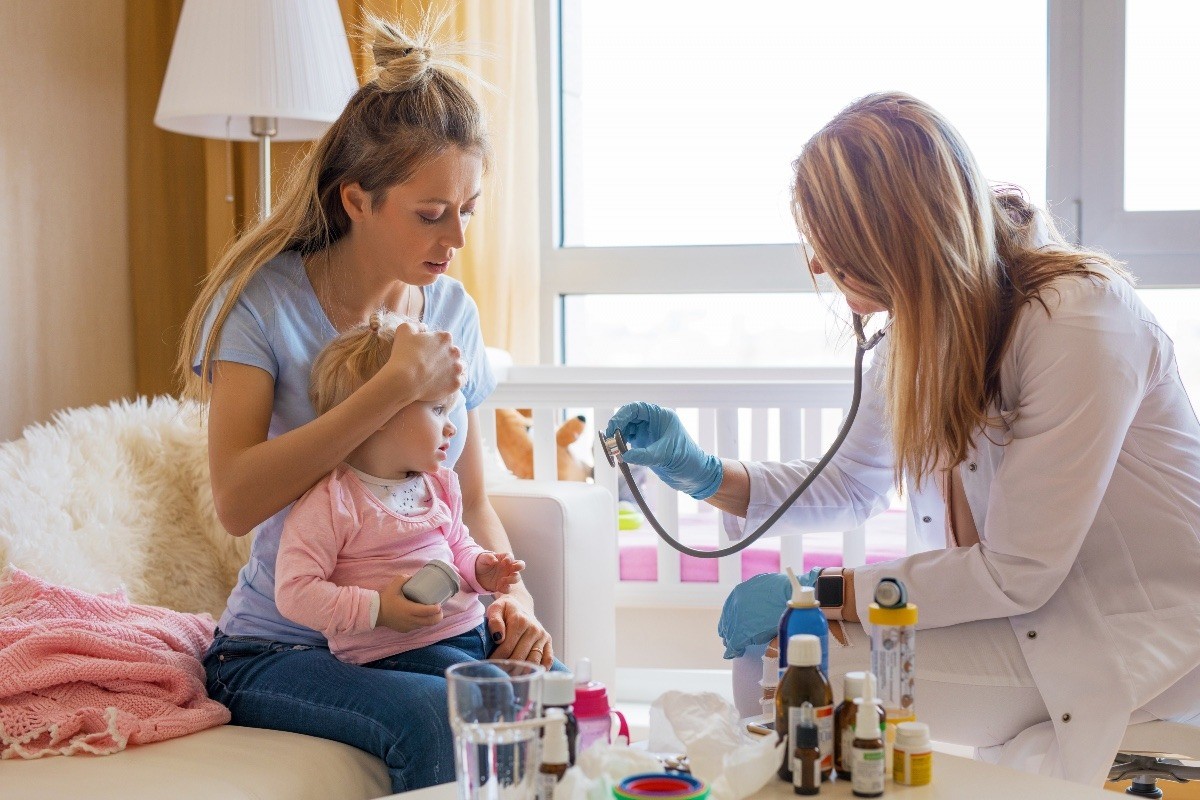
Bronchiolitis: symptoms, causes and treatment
Bronchiolitis is an acute viral infection that affects the respiratory system, particularly that of children under one year of age
The disease manifests itself most frequently in the first six months of life and has the highest incidence between November and March.
The respiratory syncytial virus (VRS) causes the disease, generally in 75% of cases
However, other viruses can also affect children’s systems, such as metapneumovirus, coronavirus, rhinovirus, adenovirus, influenza and parainfluenza viruses.
The infection is secondary to a transmission that occurs primarily by direct contact with infected secretions.
The infection phase typically lasts 6 to 10 days.
The virus mainly attacks the bronchi and bronchioles, causing an inflammatory process, which leads to increased mucus production and airway obstruction with possible respiratory distress.
CHILD HEALTH: LEARN MORE ABOUT MEDICHILD BY VISITING THE BOOTH AT EMERGENCY EXPO
The symptoms of bronchiolitis
Bronchiolitis in children generally manifests itself with fever and rhinitis, i.e. nasal inflammation.
Persistent coughing, which may become acute, and breathing difficulties, which may be characterised by an increased respiratory rate and intercostal indentations, may then appear.
In most cases, bronchiolitis resolves on its own, without serious consequences.
The causes
Factors that can increase the risk of bronchiolitis and for the condition to worsen are prematurity, the child’s age (< 12 weeks), congenital heart disease, bronchopulmonary dysplasia, cystic fibrosis, congenital airway abnormalities and immunodeficiencies.
The diagnosis of bronchiolitis is clinical
The paediatrician assesses the course of symptoms and prescribes treatment.
Only in special cases can certain laboratory and/or instrumental investigations be carried out, such as, for example, the search for respiratory viruses on nasopharyngeal aspirate, determination of oxygenation by means of a saturimeter and arterial haemogasanalysis, i.e. a test that assesses blood oxygenation.
In some cases also by measuring carbon dioxide and the efficiency of gas exchange.
A chest X-ray is rarely required in the case of possible thickening of mucus and areas of airlessness in several areas of the lungs due to impaired ventilation.
How to prevent bronchiolitis
Usually, a few simple rules of daily hygiene are enough to reduce the risk of contracting bronchiolitis or to avoid related infections, which can worsen the clinical picture.
It is always important to
- avoid contact of younger children with other children of the same age or adults with airway infections;
- always wash your hands before and after caring for your child;
- encourage breastfeeding;
- carry out nasal washes with physiological or hypertonic solution;
- never smoke in front of the child and also in a different environment where the child is not at the moment.
Treatment for bronchiolitis
The patient with bronchiolitis should have frequent nasal washes with mucus aspiration and undergo aerosol therapy with 3% hypertonic solution.
This serves the child to mobilise the abundant catarrhal mucous secretions.
In more severe cases or if bronchiolitis persists, oral cortisone may be prescribed.
Although the most recent scientific literature does not show that children undergoing this therapy improve.
The use of antibiotics is strongly discouraged.
When is hospitalisation necessary?
When bronchiolitis becomes acute, hospitalisation may be necessary, especially under six months of age.
In infants of these months, there is often a drop in saturation levels, i.e. oxygen in the blood, and dehydration may occur due to the difficulty of feeding and the increased water loss caused by respiratory work.
In addition, the risk of apnoea is higher in premature babies or those born less than 6 weeks old.
The episode of prolonged respiratory pause must be monitored by assessing the cardio-respiratory parameters.
Generally, the disease is benign and resolves spontaneously in about 12 days.
Read Also
Emergency Live Even More…Live: Download The New Free App Of Your Newspaper For IOS And Android
Bronchiolitis: Symptoms, Diagnosis, Treatment
Bronchiolitis In Paediatric Age: The Respiratory Syncytial Virus (VRS)
Bronchiolitis In Infants: Symptoms
What Is Chronic Obstructive Pulmonary Disease (COPD)?
Respiratory Syncytial Virus (RSV): How We Protect Our Children
Respiratory Syncytial Virus (RSV), 5 Tips For Parents
Infants’ Syncytial Virus, Italian Paediatricians: ‘Gone With Covid, But It Will Come Back’
Symptoms Of Emergencies In Children: Fever
What Is Traumatic Brain Injury (TBI)?
Paediatric Toxicological Emergencies: Medical Intervention In Cases Of Paediatric Poisoning
Paediatric Seasonal Illnesses: Acute Infectious Rhinitis
Pediatrics: What To Do In Case Of High Fever In Children?
Seasonal Illnesses: What To Eat When You Have Flu?
Plaques In The Throat: How To Recognise Them
Tonsillitis: Symptoms, Diagnosis And Treatment
Sore Throat: How To Diagnose Strep Throat?
Sore Throat: When Is It Caused By Streptococcus?
Pharyngotonsillitis: Symptoms And Diagnosis
Flu Vaccine For Children? Paediatricians: ‘Do It Now, Epidemic Already Started’
Paediatrics / Recurrent Fever: Let’s Talk About Autoinflammatory Diseases
Q Fever: What It Is, How To Diagnose It And How To Treat It
Respiratory Allergies: Symptoms And Treatment
RSV (Respiratory Syncytial Virus) Surge Serves As Reminder For Proper Airway Management In Children
Acute And Chronic Sinusitis: Symptoms And Remedies
Symptoms And Remedies Of Allergic Rhinitis
Respiratory Or Food Allergies: What Is The Prick Test And What Is It For?
Anaphylactic Shock: What It Is And How To Deal With It
Sinusitis: How To Recognise That Headache Coming From The Nose
Sinusitis: How To Recognise And Treat It
Flu Vaccine For Children? Paediatricians: ‘Do It Now, Epidemic Already Started’
Rhinitis, Inflammation Of The Nasal Mucous Membranes
High Fever In Children: What Is Important To Know
Symptoms Of Bronchiolitis In Infants And Children. How Is It Treated?
Chest Pain In Children: How To Assess It, What Causes It
Bronchoscopy: Ambu Set New Standards For Single-Use Endoscope
Respiratory Distress: What Are The Signs Of Respiratory Distress In Newborns?
Respiratory Distress Syndrome (ARDS): Therapy, Mechanical Ventilation, Monitoring
Bronchopneumonia: Symptoms, Causes And Treatment
Bronchitis: Symptoms, Causes And Treatment
Bronchial Asthma: Symptoms And Treatment
Bronchitis: Symptoms And Treatment


